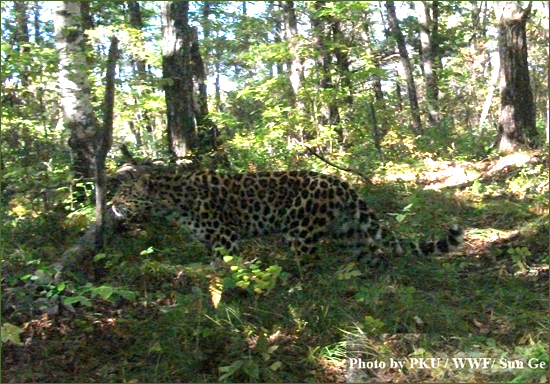Researchers capture 1st photos of amur leopard
 0 Comment(s)
0 Comment(s) Print
Print E-mail
China.org.cn, Xinhua, October 13, 2011
E-mail
China.org.cn, Xinhua, October 13, 2011
Two clear photos of the endangered amur leopard were recently taken in a forest in northeast China's Jilin Province, marking the first time for China's professional researchers to get photos of the rare animal since 1949, researchers said on Wednesday.
|
The amur leopard, one of the world's most endangered large cats, has been spotted in a forest in the province's Yanbian prefecture, according to Sun Ge, a doctoral candidate at Peking University. |
The amur leopard, one of the world's most endangered large cats, has been spotted in a forest in the province's Yanbian prefecture, according to Sun Ge, a doctoral candidate at Peking University who set up automatic infrared cameras in the forest to capture images of the animal.
Sun and his assistant set up 40 of the cameras three months ago, returning to collect photos every twenty days. One of the cameras managed to capture the animal on Sept. 19 in Wangqing County, which borders Russia and the Democratic People's Republic of Korea (DPRK).
Sun's work is part of a field research project jointly sponsored by Jilin's provincial forest authorities and the World Wildlife Fund (WWF).
China's frontier guard troop previously took pictures of the amur leopard on April 13 this year in the Huichun Nature Reserve in Yanbian, according to the WWF.
The total number of amur leopards living in the wild is believed to be no more than 50 worldwide, with about ten living in China, Sun said. The number was derived from interviewing researchers, as no systematic field research concerning the animals has ever been conducted in China, he said.
The species used to be more widely distributed, but shrunk due to a lack of prey, Sun said, adding that environmental damage and poaching are also to blame.
Footprints and the photos Sun captured prove that Wangqing is an independent habitat for the animal, according to Jiang Guangshun, a professor of animal protection at Northeast Forestry University.
A nature reserve in Wangqing County will play an important role in future protection work for the amur leopard, as it is the most important habitat for the leopard and may be the first habitat for female tigers from the Russian forest, Jiang said.
The Jilin Forestry Department is planning to establish a habitat on Changbaishan Mountain for Siberian tigers, while the Wangqing Provincial Nature Reserve will be promoted to national reserve status, both of which will provide better living conditions for the amur leopard, said Yu Changchun, director of the department's Animal and Plant Protection Service Office.







Go to Forum >>0 Comment(s)